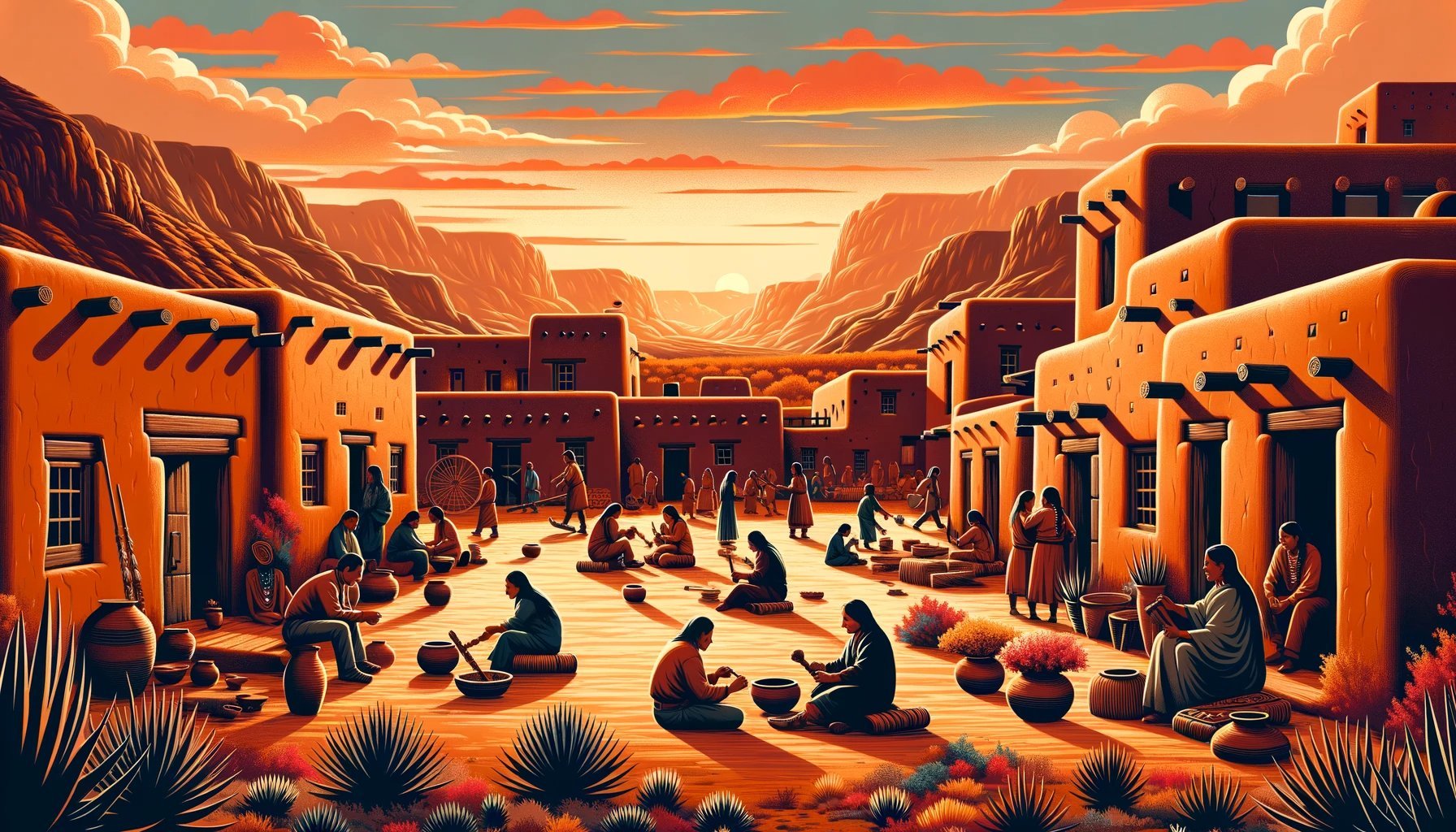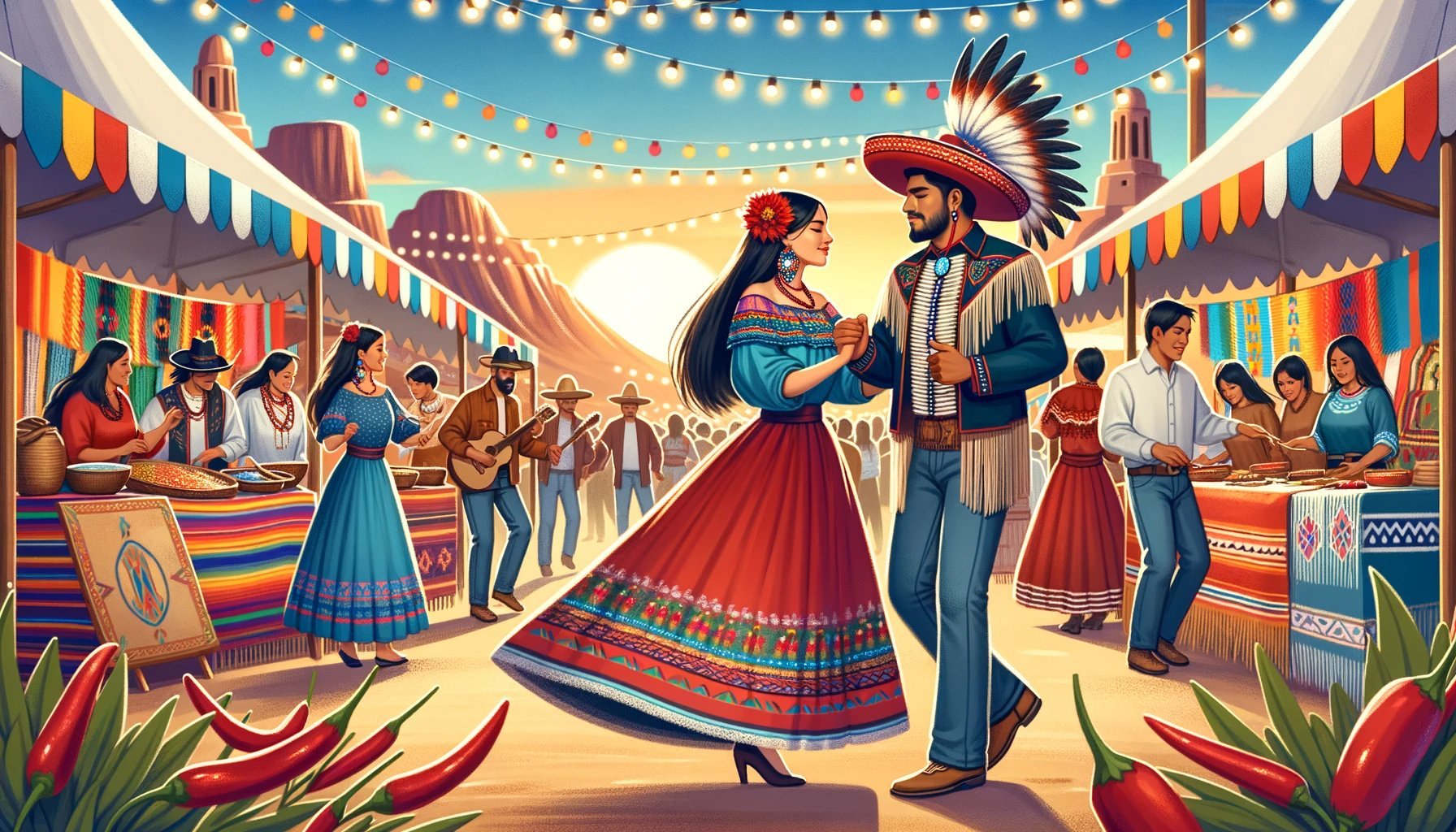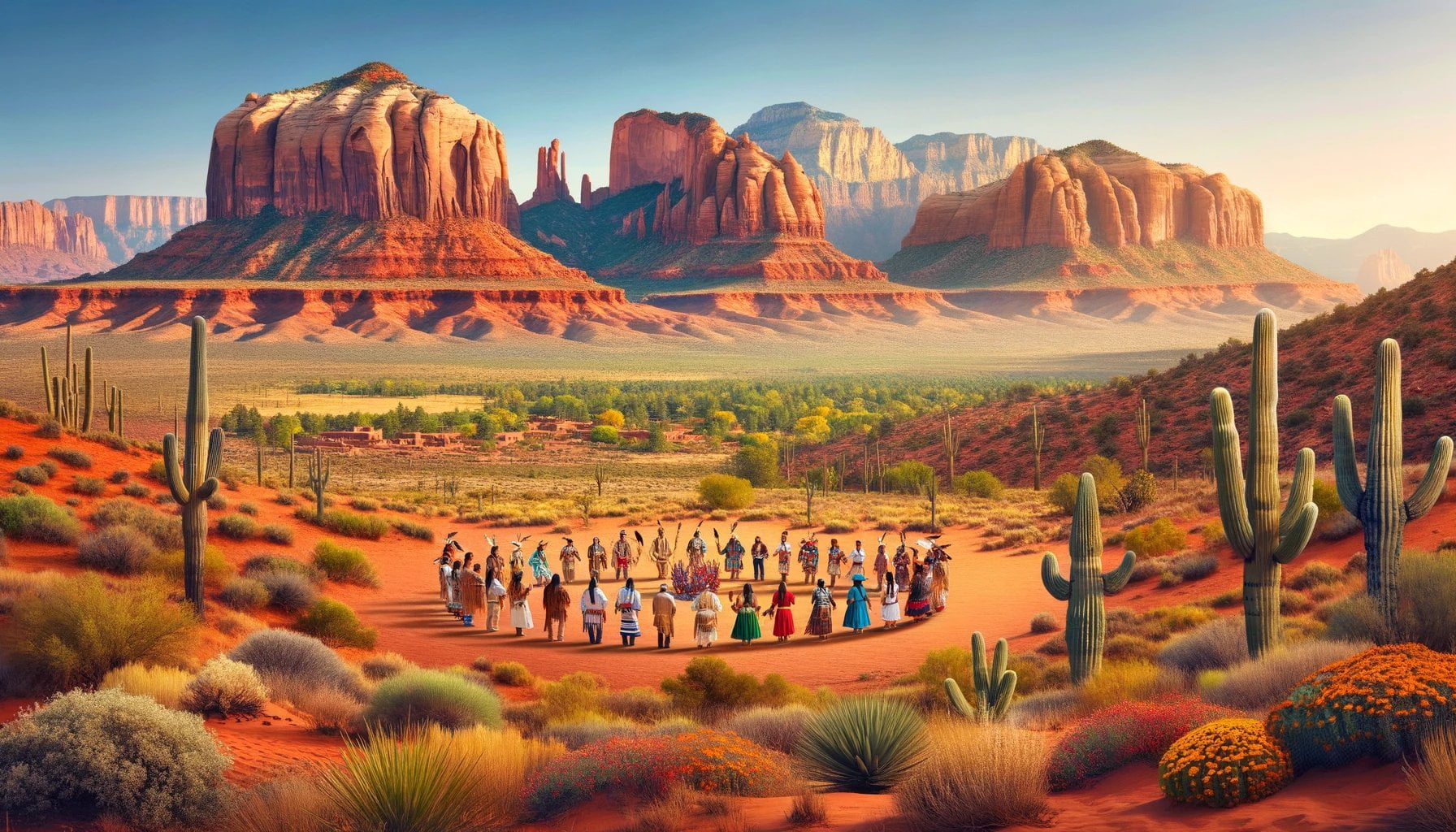Unveiling the Vibrant Culture of the Southwest takes readers on a captivating journey into the heart of this region’s main culture. With an expert travel writer who has spent over a decade exploring the Southwest, this article offers a unique insight into the rich and diverse tapestry of traditions, art, music, and culinary delights that define this remarkable part of the United States. Prepare to be immersed in a world where ancient customs blend harmoniously with contemporary influences, creating a cultural experience like no other.

Key Takeaways:
- The Southwest region of the United States has been influenced by the Paleo-Indian, Southwestern Archaic, and Post-Archaic traditions.
- These traditions reflect the diversity of the Yuman, O’odham, and Pueblo peoples who inhabited the region.
- The Southwest is characterized by its distinctive building traditions, languages, religions, and foods.
- The cultural diversity in the Southwest is a result of the Spanish, Mexican, Indian, and Anglo cultures that have shaped its history.
What is the main culture in the Southwest region?
The Southwest region of the United States is a rich tapestry of cultures that have shaped its vibrant and diverse identity. From ancient traditions to modern influences, the Southwest is a melting pot of history, art, cuisine, and architecture. In this article, we will delve into the main culture of the Southwest region and explore the fascinating elements that make it so unique.
A Blend of Traditions
The main culture in the Southwest region has been influenced by three major cultural traditions: the Paleo-Indian tradition, the Southwestern Archaic tradition, and the Post-Archaic cultures tradition. These traditions reflect the rich diversity of the peoples who inhabited the region, including the Yuman, O’odham, and Pueblo peoples. Each tradition left its mark on the development of the region’s identity, contributing to the vibrant cultural landscape we see today.
Distinctive Building Traditions
One of the defining features of the Southwest is its distinctive building traditions. The architecture of the region is a reflection of its history and cultural influences. From the adobe structures of the Native American pueblos to the Spanish colonial missions, the Southwest’s architectural heritage is a testament to the blending of cultures over time.
Languages and Religions
The Southwest region is home to a diverse range of languages and religions. The Native American tribes of the Southwest have their own unique languages, each with its own rich history and cultural significance. Spanish, brought by the early Spanish explorers and settlers, also plays a significant role in the linguistic landscape of the region. In terms of religion, the Southwest is a melting pot of beliefs, with Native American spirituality, Catholicism, and various other faiths coexisting and shaping the cultural fabric of the region.
Culinary Delights
When it comes to food, the Southwest is known for its bold and flavorful cuisine. Influenced by the Spanish, Mexican, Native American, and Anglo cultures, Southwestern cuisine is a fusion of traditional flavors and ingredients. From spicy chili peppers and corn-based dishes to delicious Tex-Mex staples like tacos and enchiladas, the culinary traditions of the Southwest reflect the diverse cultural influences that have shaped the region.
The Artistic Spirit
Art is deeply ingrained in the culture of the Southwest. From ancient petroglyphs and pottery to vibrant modern murals and sculptures, art is a powerful medium for preserving cultural heritage and expressing contemporary creativity. The Southwest is home to numerous art galleries, museums, and cultural centers that showcase the rich artistic traditions of the region.
Conclusion
In conclusion, the main culture of the Southwest region is a harmonious amalgamation of ancient traditions and modern influences. From the diverse cultural traditions of the Native American tribes to the Spanish, Mexican, and Anglo influences, the Southwest is a vibrant tapestry of history, art, language, religion, and cuisine. Exploring the Southwest is like embarking on a journey through time and cultural diversity, where the past and present intertwine to create a truly unique and captivating experience.
Here are some interesting facts about the Southwest region. Did you know that it is home to diverse landscapes including deserts, canyons, and mountains? Discover more fascinating information about the Southwest region here!
Ever wondered how old the Southwest region is? Find out the answer to this intriguing question here and uncover the rich history that has shaped this unique part of the country.
When it comes to the Southwest region, certain aspects hold great significance. Explore what makes this region important and learn more about its cultural and natural heritage by clicking here.
Mexican and Hispanic Influences in Southwest Culture
Key Takeaways:
– Hispanic culture in the Southwest region of the United States is a topic of academic interest and research, with a significant influence from Spanish and Mexican cultures on Mexican American culture.
– The Southwest region still showcases evidence of its Mexican heritage, with historical data on Spanish-Mexican exploration and settlement patterns being analyzed to understand Hispanic culture.
– The University of New Mexico has conducted research on Mexican American values in the American Southwest, highlighting the ongoing importance of Hispanic culture in the region.
– The Southwest’s distinct culture is influenced by Native American traditions and Spanish colonization, with major cultural traditions including the Paleo-Indian, Southwestern Archaic, and Post-Archaic cultures. Indigenous groups have played a vital role in the region’s history and culture.
Hispanic Culture in the Southwest:
The vibrant culture of the Southwest region of the United States is enriched by diverse influences, including Mexican and Hispanic traditions. The fusion of Native American and Spanish elements creates a unique cultural tapestry that has shaped the identity of the Southwest.
Spanish and Mexican Influences:
The influence of Spanish and Mexican cultures on Mexican American culture is undeniable. A book published in 1994 examined the profound impact of Spanish contributions on Mexican American culture, while also acknowledging the significance of indigenous elements. Spanish colonization and the establishment of missions, ranchos, and towns have left a lasting imprint on the Southwest region.
The Mexican Heritage:
The Mexican heritage in the Southwest is still apparent today. Historical data related to Spanish-Mexican exploration and settlement patterns in the region provide valuable insights into the development of Hispanic culture. As the University of New Mexico conducts research on Mexican American values, it highlights the ongoing importance and relevance of Hispanic culture in the American Southwest.
Distinct Southwest Culture:
The Southwest has its own distinct culture, influenced by Native American traditions and Spanish colonization. The region’s rich history includes major cultural traditions such as the Paleo-Indian, Southwestern Archaic, and Post-Archaic cultures. These indigenous groups have played a significant role in shaping the Southwest’s cultural identity.
In reading about the Southwest region’s culture and heritage, it becomes clear that Mexican and Hispanic influences are deeply ingrained. From Spanish colonial architecture to the fusion of flavors in southwestern cuisine, the region’s cultural richness is a testament to the enduring legacy of Mexican and Hispanic traditions.
Sources:
– Duke University Press: “Hispanic Culture in the Southwest” – source
– Study.com: “How Mexico Influenced Life in the Early American Southwest” – source
Art and Music in the Southwest
The Southwest region of the United States is known for its rich and vibrant culture, which is beautifully expressed through art and music. From ancient pottery to contemporary sculptures, the art of the Southwest reflects the diverse traditions and influences of its people. Likewise, the music of the Southwest resonates with the sounds of Native American melodies, Spanish rhythms, and Western influences. Let’s delve into the captivating world of art and music in the Southwest.
Ancient Art of the Southwest
The ancient civilizations of the Southwest left behind a remarkable artistic legacy. The Ancient Puebloans, also known as the Anasazi, created intricate pottery such as the Acoma pottery, featuring traditional designs like thunderbirds, geometric patterns, and rainbows. The pottery of the Mimbres culture, a subgroup of the Mogollon culture, is known for its narrative paintings. These ancient artworks provide a glimpse into the cultural heritage of the Southwest.
Influence of Native American Art
Native American art continues to be a significant part of the artistic landscape of the Southwest. Native artists from tribes like the Santa Clara Pueblo showcase their talent through sculptures like “For Life in all Directions” by Roxanne Swentzell. The art of sandpainting and weaving, practiced by Athabaskan peoples such as the Navajo and Apache, adds diversity and depth to the region’s artistic traditions.
Spanish Influence on Art
The Spanish colonization of the Southwest introduced new artistic elements that are still prevalent today. The Spanish brought the tradition of woodworking, tinsmith, farming, and leatherwork to the region. The introduction of silverworking in the 19th century paved the way for the incorporation of silver into Southwest jewelry, resulting in distinctive and exquisite pieces.
Modern Art Movements
The art scene in the Southwest has also seen the emergence of modern art movements. The Studio at the Santa Fe Indian School, established in 1932, played a crucial role in formalizing traditional design elements in flatstyle Native American art. Additionally, the completion of the Santa Fe Railroad after World War I led to the growth of artists’ colonies, attracting creatives to regions like Santa Fe and Taos.
Music of the Southwest
The music of the Southwest is as diverse and vibrant as its art. Native American melodies, with their hypnotic rhythms and soulful tones, have been passed down through generations. Spanish influences infused the music with passionate guitar melodies and rhythmic beats. Western-themed ballads and country music resonate with the region’s rich cowboy culture. When exploring the Southwest, one can witness the harmonious blend of these distinct musical traditions.
Key Takeaways:
- The art of the Southwest includes various forms such as pottery, painting, sculpture, and jewelry-making.
- Ancient civilizations like the Ancient Puebloans and Mimbres culture have left behind remarkable art legacies.
- Native American art showcases the talent and cultural heritage of tribes in the Southwest.
- Spanish colonization introduced woodworking, leatherwork, and silverworking to the region’s artistic traditions.
- Modern art movements and artists’ colonies have contributed to the evolving art scene in the Southwest.
- The music of the Southwest incorporates Native American melodies, Spanish influences, and Western-themed ballads.
Sources:
– Art of the American Southwest – Wikipedia
Culinary Traditions of the Southwest
When exploring the vibrant culture of the Southwest region, one cannot ignore the enticing culinary traditions that have shaped this unique part of the United States. From the fusion of Native American ingredients to the Spanish and Mexican influences, Southwestern cuisine offers a delightful blend of flavors and techniques.
The “Three Sisters” and Native American Influence
At the heart of Southwestern cuisine are the “three sisters” – corn, beans, and squash. These three ingredients have been staple foods in the Southwest since ancient times, cultivated and consumed by Native American tribes. NativeTribe.info provides a comprehensive guide on traditional foods of the Southwest tribes, highlighting the reliance on the “three sisters” and the consumption of various types of wild game[^1].
Spanish and Mexican Influences
Spanish and Mexican settlers also left their mark on Southwestern cuisine, introducing new ingredients that enriched the culinary landscape. Wheat flour, melons, bell peppers, summer squashes, zucchini, artichokes, tomatoes, peaches, and apricots are just a few examples of the ingredients that made their way into Southwestern cooking, adding depth and diversity to the flavors[^2].
Preservation Methods
Preservation methods play a significant role in Southwestern cuisine, allowing for the enjoyment of foods throughout the year. Native American tribes in the Southwest employed various techniques, including drying and smoking, to preserve foods like meat and fish. These preservation methods not only ensured food availability but also added distinct flavors to the dishes[^3].
Cultural Traditions and Culinary Heritage
The culinary traditions of the Southwest are intertwined with the region’s rich cultural history. The Paleo-Indian, Southwestern Archaic, and Post-Archaic cultures have all contributed to shaping the main culture of the Southwest. Each culture has left its own distinct mark on the cuisine, creating a tapestry of flavors and techniques that reflect the region’s diverse heritage[^4].
Key Takeaways:
- Southwestern cuisine is a fusion of Native American ingredients, Spanish influences, and Mexican flavors.
- The “three sisters” – corn, beans, and squash – are staple foods in the Southwest, cultivated and consumed since ancient times.
- Spanish and Mexican settlers introduced new ingredients, expanding the culinary diversity of the region.
- Preservation methods such as drying and smoking have played a significant role in Southwestern cuisine.
- The culinary traditions of the Southwest are deeply intertwined with the region’s cultural history.
Citations:
[^1]: NativeTribe.info – Traditional Foods of the Southwest Tribe
[^2]: Eater – What Is Southwestern Food?
[^3]: Lumen Learning – Preservation Techniques in Native American Southwest Culture
[^4]: Lumen Learning – Exploring the Cultural Traditions of the Southwest

FAQ
Q1: What are the main cultural traditions in the Southwest region of the United States?
A1: The main cultural traditions in the Southwest region include the Paleo-Indian tradition, the Southwestern Archaic tradition, and the Post-Archaic cultures tradition. These traditions reflect the rich diversity of the peoples who inhabited the region, such as the Yuman, O’odham, and Pueblo peoples.
Q2: How has the Southwest region’s culture been influenced by different cultures?
A2: The culture of the Southwest region has been influenced by different cultures, including the Spanish, Mexican, Indian, and Anglo cultures. These influences have contributed to the distinctive building traditions, languages, religions, and foods of the region.
Q3: What are the key ingredients in Southwestern cuisine?
A3: The key ingredients in Southwestern cuisine are corn, beans, and squash, also known as the “three sisters.” These ingredients have been staple foods in the region since ancient times and were cultivated and consumed by Native American tribes. Spanish and Mexican settlers also introduced new ingredients to the cuisine, such as wheat flour, melons, bell peppers, and tomatoes.
Q4: How have preservation methods played a role in Southwestern cuisine?
A4: Preservation methods have played a significant role in Southwestern cuisine. Native American tribes in the Southwest used techniques like drying and smoking to preserve foods like meat and fish. These preservation methods allowed them to store food for longer periods and ensure a stable food supply.
Q5: Where can I learn more about the culinary traditions of the Southwest?
A5: To learn more about the culinary traditions of the Southwest, you can visit NativeTribe.info, which provides a guide on traditional foods of the Southwest tribes. The website discusses the reliance on the “three sisters” and the consumption of various types of wild game. Additionally, Eater offers an article explaining the historical significance of corn, beans, and squash in Southwestern cooking.
- Unveiling the Enigma: Mansoureh Khojasteh Bagherzadeh’s Public Appearances & Private Life in Iran - July 18, 2025
- Unveiling the Mystery: Mansoureh Khojasteh Bagherzadeh’s Husband: A Rare Glimpse into a Private Life - July 18, 2025
- Unveiling Masoud Khamenei’s Mother: Power, Influence, and Iran’s Future - July 18, 2025
















